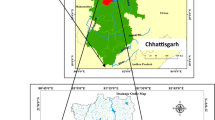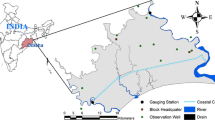Abstract
The growing demand for food is the key player for the over-exploitation of groundwater for agriculture in many parts of the globe, which is manifested with a rapid decline in the water table. Without any focus on artificial recharge, over-exploitation of groundwater for irrigation is a common practice in the Kantamal catchment of the Mahanadi river basin, which is prone to frequent droughts. In this research, a GIS-based multi-criteria decision making (MCDM) approach was employed to delineate the potential groundwater recharge sites. The thematic layers influencing groundwater recharge including lithology, geomorphology, lineament density, slope, soil texture, drainage density, soil hydraulic conductivity, land use/land cover, rainfall and pre-monsoon groundwater depths were used to identify the suitable recharge areas. Based on the analytical hierarchy process (AHP), different weights were allocated to the themes and their features. The delineated groundwater recharge zones are categorised as: very good, good, moderate and poor zones. It is observed that 27% of the catchment has very good and 38% has good groundwater recharge potential. Moderate and poor recharge zones cover 26% and 9% of the catchment, respectively. The groundwater recharge zones were validated using observed dynamic groundwater data of existing well points. The recharge zones having very good, good, moderate and poor groundwater potential showed 67%, 57.6%, 42.1% and 55.5% matching with the areas having very good, good, moderate and poor dynamic groundwater potential, respectively. The study suggests the imposition of restrictions on anthropogenic activities in these potential recharge areas and the installation of appropriate groundwater recharge structures for ensuring sustainable groundwater recharge.




Similar content being viewed by others
Data Availability
All the data used in this study are available with the author(s).
Code Availability
ArcGIS software has been used in this study, which is available with ESRI.
References
Ahmed, A., Alrajhi, A., & Alquwaizany, A. S. (2021). Identification of groundwater potential recharge zones in flinders ranges, South Australia using remote sensing, GIS and MIF techniques. Water, 13(18), 2571. https://doi.org/10.3390/w13182571.
Arulbalaji, P., Padmalal, D., & Sreelash, K. (2019). GIS and AHP techniques based delineation of groundwater potential zones: A case study from southern Western Ghats, India. Scientific Reports, 9(1), 1–17. https://doi.org/10.1038/s41598-019-38567-x.
Bera, A., Mukhopadhyay, B. P., & Barua, S. (2020). Delineation of groundwater potential zones in Karha river basin, Maharashtra, India, using AHP and geospatial techniques. Arabian Journal of Geosciences, 13(15), 1–21. https://doi.org/10.1007/s12517-020-05702-2.
Boretti, A., & Rosa, L. (2019). Reassessing the projections of the world water development report. NPJ Clean Water, 2(1), 1–6. https://doi.org/10.1038/s41545-019-0039-9.
CGWB. 2011. Dynamic Ground Water Resources of India. http://cgwb.gov.in/Documents/Dynamic-GW-Resources-2009.pdf. Accessed 14 Aug 2021.
CGWB. 2019. National compilation on dynamic ground water resources of India. http://cgwb.gov.in/GW-Assessment/GWRA-2017-National-ompilation.pdf. Accessed 14 Aug 2021.
Das, D. M., Majhi, D., Sahoo, B. C., Sahoo, S., Raul, S. K., & Panigrahi, B. (2020). Delineation of groundwater potential zones in the middle catchment of Mahanadi River basin using remote sensing and GIS. International Journal of Current Microbiology and Applied Sciences, 9(2), 1829–1841. https://doi.org/10.20546/ijcmas.2020.902.209.
Das, D. M., Nayak, D., Sahoo, B. C., Raul, S. K., Panigrahi, B., & Choudhary, K. K. (2022). Identification of potential groundwater zones in rice-fallow areas within the Mahanadi river basin, India, using GIS and the analytical hierarchy process. Environmental Earth Sciences, 81(15), 1–17. https://doi.org/10.1007/s12665-022-10517-3.
Dhar, A., Sahoo, S., & Sahoo, M. (2015). Identification of groundwater potential zones considering water quality aspect. Environmental Earth Sciences, 74(7), 5663–5675. https://doi.org/10.1007/s12665-015-4580-7.
Ghosh, A., & Mukhopadhyay, S. (2016). Quantitative study on shoreline changes and erosion hazard assessment: Case study in Muriganga-Saptamukhi interfluve, Sundarban, India. Modeling Earth Systems and Environment, 2(2), 1–14. https://doi.org/10.1007/s40808-016-0130-x.
Goitsemang, T., Das, D. M., Raul, S. K., Subudhi, C. R., & Panigrahi, B. (2020). Assessment of groundwater potential in the Kalahandi district of Odisha (India) using remote sensing, geographic information system and analytical hierarchy process. Journal of the Indian Society of Remote Sensing, 48(12), 1739–1753. https://doi.org/10.1007/s12524-020-01188-3.
Jasrotia, A. S., Kumar, R., Taloor, A. K., & Saraf, A. K. (2019). Artificial recharge to groundwater using geospatial and groundwater modelling techniques in North Western Himalaya, India. Arabian Journal of Geosciences, 12(24), 1–23. https://doi.org/10.1007/s12517-019-4855-5
Jena, S., Panda, R. K., Ramadas, M., Mohanty, B. P., & Pattanaik, S. K. (2020). Delineation of groundwater storage and recharge potential zones using RS-GIS-AHP: Application in arable land expansion. Remote Sensing Applications: Society and Environment, 19, 100354. https://doi.org/10.1016/j.rsase.2020.100354.
Kaliraj, S., Chandrasekar, N., & Magesh, N. S. (2014). Identification of potential groundwater recharge zones in Vaigai upper basin, Tamil Nadu, using GIS-based analytical hierarchical process (AHP) technique. Arabian Journal of Geosciences, 7(4), 1385–1401. https://doi.org/10.1007/s12517-013-0849-x.
Khan, A., Govil, H., Taloor, A. K., & Kumar, G. (2020). Identification of artificial groundwater recharge sites in parts of Yamuna River basin India based on Remote Sensing and Geographical Information System. Groundwater for Sustainable Development, 11, 100415. https://doi.org/10.1016/j.gsd.2020.100415
Kumar, B., & Kumar, U. (2011). Ground water recharge zonation map** and modeling using geomatics techniques. International Journal of Environmental Sciences, 1(7), 1670.
Kumar, P., Herath, S., Avtar, R., & Takeuchi, K. (2016). Map** of groundwater potential zones in Killinochi area, Sri Lanka, using GIS and remote sensing techniques. Sustainable Water Resources Management, 2(4), 419–430. https://doi.org/10.1007/s40899-016-0072-5.
Machiwal, D., Jha, M. K., & Mal, B. C. (2011). Assessment of groundwater potential in a semi-arid region of India using remote sensing, GIS and MCDM techniques. Water Resources Management, 25(5), 1359–1386. https://doi.org/10.1007/s11269-010-9749-y.
Magesh, N. S., Chandrasekar, N., & Soundranayagam, J. P. (2011). Morphometric evaluation of Papanasam and Manimuthar watersheds, parts of Western Ghats, Tirunelveli district, Tamil Nadu, India: A GIS approach. Environmental Earth Sciences, 64(2), 373–381. https://doi.org/10.1007/s12665-010-0860-4.
Maizi, D., Boufekane, A., Ait Ouali, K., & Aoudia, M. (2020). Identification of potential area of recharge using geospatial and multi-criteria decision analysis in the Macta watershed (Western Algeria). Arabian Journal of Geosciences, 13(3), 1–14. https://doi.org/10.1007/s12517-020-5076-7.
Mukherjee, A., Bhanja, S. N., & Wada, Y. (2018). Groundwater depletion causing reduction of baseflow triggering Ganges river summer drying. Scientific Reports, 8(1), 1–9. https://doi.org/10.1038/s41598-018-30246-7.
Narendra, K., Nageswara Rao, K., & Swarna Latha, P. (2013). Integrating remote sensing and GIS for identification of groundwater prospective zones in the Narava basin, Visakhapatnam region, Andhra Pradesh. Journal of the Geological Society of India, 81(2), 248–260. https://doi.org/10.1007/s12594-013-0028-4.
Olabode, O. F. (2019). Potential groundwater recharge sites map** in a typical basement terrain: A GIS methodology approach. Journal of Geovisualization and Spatial Analysis, 3(1), 1–17. https://doi.org/10.1007/s41651-019-0028-z.
Panda, B., Sabarathinam, C., Nagappan, G., Rajendiran, T., & Kamaraj, P. (2020). Multiple thematic spatial integration technique to identify the groundwater recharge potential zones–A case study along the Courtallam region, Tamil Nadu, India. Arabian Journal of Geosciences, 13(24), 1–16. https://doi.org/10.1007/s12517-020-06223-8.
Patil, N., Reddy, V. P., Patangray, A., & Singh, S. K. (2018). Map** groundwater recharge potential using GIS approach in Darwha block. Arabian Journal of Geosciences, 11(1), 1–15. https://doi.org/10.1007/s12517-017-3324-2.
PIB (2020). Extraction of groundwater. https://pib.gov.in/PressReleasePage.aspx?PRID=1602634. Accessed 10 Oct 2021
Qureshi, A. S., McCornick, P. G., Sarwar, A., & Sharma, B. R. (2010). Challenges and prospects of sustainable groundwater management in the Indus Basin, Pakistan. Water resources management, 24(8), 1551–1569. https://doi.org/10.1007/s11269-009-9513-3.
Rajasekhar, M., Gadhiraju, S. R., Kadam, A., & Bhagat, V. (2020). Identification of groundwater recharge-based potential rainwater harvesting sites for sustainable development of a semiarid region of southern India using geospatial, AHP and SCS-CN approach. Arabian Journal of Geosciences, 13(1), 1–19. https://doi.org/10.1007/s12517-019-4996-6.
Rao, B. V., Nune, R., Rajesh, M. V. S., & Sarada, S. V. (2011). Large scale groundwater withdrawal and its consequences on the closing of the upper Musi basin in India. International Journal of Water, 6(1–2), 15–28. https://doi.org/10.1504/IJW.2011.043314.
Ratha, K. C. (2019). Growing industrialisation and its cumulative impacts: Insights from the Mahanadi River basin. Social Change, 49(3), 519–530. https://doi.org/10.1177/0049085719863904.
Saaty, T. L. (1980). The analytic hierarchy process: planning, priority setting, resource allocation (p. 287). McGraw-Hill.
Sandoval, J. A., & Tiburan, C. L., Jr. (2019). Identification of potential artificial groundwater recharge sites in Mount Makiling Forest Reserve, Philippines using GIS and Analytical Hierarchy Process. Applied Geography, 105, 73–85. https://doi.org/10.1016/j.apgeog.2019.01.010.
Silwal CB, Pathak D (2018). Review on practices and state of the art methods on delineation of ground water potential using GIS and remote sensing. Bulletin of the Department of Geology. https://doi.org/10.3126/bdg.v20i0.20717
Singh, S. K., Zeddies, M., Shankar, U., & Griffiths, G. A. (2019). Potential groundwater recharge zones within New Zealand. Geoscience Frontiers, 10(3), 1065–1072. https://doi.org/10.1016/j.gsf.2018.05.018.
USGS. 2012. Infiltration and the water cycle. https://www.usgs.gov/special-topic/water-science-school/science/infiltration-and-water-cycle?qt-science_center_objects=0#qt-science_center_objects. Accessed 7 Oct 2021.
Velis, M., Conti, K. I., & Biermann, F. (2017). Groundwater and human development: Synergies and trade-offs within the context of the sustainable development goals. Sustainability Science, 12(6), 1007–1017. https://doi.org/10.1007/s11625-017-0490-9.
Vellaikannu, A., Palaniraj, U., Karthikeyan, S., Senapathi, V., Viswanathan, P. M., & Sekar, S. (2021). Identification of groundwater potential zones using geospatial approach in Sivagangai district, South India. Arabian Journal of Geosciences, 14(1), 1–17. https://doi.org/10.1007/s12517-020-06316-4.
Verma, P., Singh, P., & Srivastava, S. K. (2020). Development of spatial decision-making for groundwater recharge suitability assessment by considering geoinformatics and field data. Arabian Journal of Geosciences, 13(8), 1–18. https://doi.org/10.1007/s12517-020-05290-1.
WWAP. 2009. Water in a Changing World. World Water Development Report 3. UNESCO, Paris.
Yahiaoui, B., Agoubi, B., & Kharroubi, A. (2021). Groundwater potential recharge areas delineation using groundwater potential recharge index (GPRI) within arid areas: Ghomrassen, south Tunisia. Arabian Journal of Geosciences, 14(11), 1–13. https://doi.org/10.1007/s12517-021-07173-5.
Acknowledgements
The authors wish to express their sincere thanks to the National Remote Sensing Centre (ISRO), Hyderabad; Central Groundwater Board, Bhubaneswar; Special Relief Commissioner (SRC), Government of Odisha; National Bureau of Soil Survey and Land Use Planning (NBSS & LUP), Nagpur; and Geological Survey of India (GSI) for providing necessary data and information that made this study possible. Necessary hardware and software support received from the College of Agricultural Engineering & Technology, Odisha University of Agriculture and Technology, Bhubaneswar, is sincerely acknowledged.
Funding
Not applicable.
Author information
Authors and Affiliations
Contributions
All the authors have contributed significantly for the execution of this work.
Corresponding author
Ethics declarations
Conflict of interest
Not applicable.
Additional information
Publisher's Note
Springer Nature remains neutral with regard to jurisdictional claims in published maps and institutional affiliations.
About this article
Cite this article
Nayak, D., Das, D.M., Raul, S.K. et al. Delineation of Potential Groundwater Recharge Zones in the Middle Reach of Mahanadi River Basin using GIS-Based MCDM Technique. J Indian Soc Remote Sens 51, 1465–1478 (2023). https://doi.org/10.1007/s12524-023-01708-x
Received:
Accepted:
Published:
Issue Date:
DOI: https://doi.org/10.1007/s12524-023-01708-x




